Terry L. Ettinger Horticulture Consulting Services
Meeting The Needs Of Today With A Vision For The Future
Recommended Shrubs -
Witchhazels
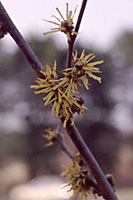 I recall the first time a witchhazel caught my eye.
It was during a drive through the F.R. Newman
Arboretum in Ithaca when I noticed
a subtle yellow blur out in one of the lawn areas. Curious, for a
reason that will become obvious in a moment, I
got out of my car - yes, after parking it - and walked up to the plant.
I recall the first time a witchhazel caught my eye.
It was during a drive through the F.R. Newman
Arboretum in Ithaca when I noticed
a subtle yellow blur out in one of the lawn areas. Curious, for a
reason that will become obvious in a moment, I
got out of my car - yes, after parking it - and walked up to the plant.
What I discovered was a medium-sized shrub covered with small, pale yellow flowers in late October, at right. That's right, late October!
Not only did I find it bizarre that a shrub was blooming so late in the year, I was also struck by how odd the spider-like, four-petaled flowers looked!
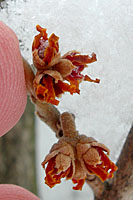 Well, I was immediately hooked (lined and sinkered, too)! The tag
hanging from a branch identified the plant as Eastern Witchhazel,
Hamamelis virginiana (that's a great thing about arboreta
and botanical gardens - the plants are usually labeled and properly
identified), and I was immediately off to learn more about this
plant.
Well, I was immediately hooked (lined and sinkered, too)! The tag
hanging from a branch identified the plant as Eastern Witchhazel,
Hamamelis virginiana (that's a great thing about arboreta
and botanical gardens - the plants are usually labeled and properly
identified), and I was immediately off to learn more about this
plant.
What I quickly discovered was that this plant isn't confined to botanical gardens. Rather, it's a relatively common multiple-stemmed medium to large shrub or small tree (fifteen to twenty-five feet tall and wide) in woodlands throughout the northeastern U.S. and southeastern Canada - including Central New York. In fact, it's easy to find all over Green Lakes State Park, Baltimore Woods and many other public and private woodlots and forests!
I also learned that in addition to our native, fall-blooming witchhazel, there are several winter (yes, winter) through early spring-blooming species and/or hybrids that can thrive in Central New York landscapes, too!
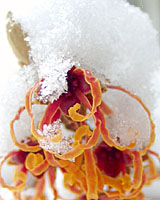 Vernal witchhazel, Hamamelis vernalis
(at left, above), for example, is native throughout the lower Mississippi River
valley from Missouri to Louisiana, yet grows well here. In fact, there's one growing in the median that runs down the
middle of Concord Place not a hundred yards from our home. I have to
say that I'm not very impressed with this species as the specimens
I've seen over the years have very small, brownish-yellow to
reddish-yellow flowers that open between late February through early
April. Also, the fall foliage color tends to be a pretty bland
yellow.
Vernal witchhazel, Hamamelis vernalis
(at left, above), for example, is native throughout the lower Mississippi River
valley from Missouri to Louisiana, yet grows well here. In fact, there's one growing in the median that runs down the
middle of Concord Place not a hundred yards from our home. I have to
say that I'm not very impressed with this species as the specimens
I've seen over the years have very small, brownish-yellow to
reddish-yellow flowers that open between late February through early
April. Also, the fall foliage color tends to be a pretty bland
yellow.
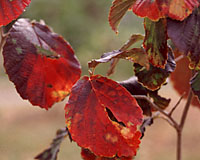 While I'm not crazy about Vernal witchhazel, many of the hybrids resulting from crosses between the Japanese witchhazel,
Hamamelis japonica, and Chinese witchhazel, Hamamelis mollis, are absolutely outstanding!
As a group, they're presented as cultivated varieties (cultivars) of Hamamelis x. intermedia.
While I'm not crazy about Vernal witchhazel, many of the hybrids resulting from crosses between the Japanese witchhazel,
Hamamelis japonica, and Chinese witchhazel, Hamamelis mollis, are absolutely outstanding!
As a group, they're presented as cultivated varieties (cultivars) of Hamamelis x. intermedia.
My long-time favorite is coppery-flowered `Jelena,' above at right. In our backyard, it blooms pretty reliably right around the end of . . . . . . are you ready for this, January - and remains effective for two to three weeks! Then, in mid-autumn its leaves turn a dramatic combination of reds, yellows, and orange, above at left!
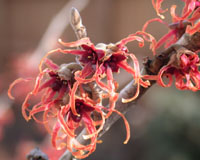 More typically, the red-flowering `Diane,'
at right, and the relatively
commonly available, yellow-flowering `Arnold's Promise,' below at
left, bloom from
about the middle of March through early April - a solid month before
forsythia! As with `Jelena,' their fall leaf color ranges pretty
reliably from red to orange-yellow.
More typically, the red-flowering `Diane,'
at right, and the relatively
commonly available, yellow-flowering `Arnold's Promise,' below at
left, bloom from
about the middle of March through early April - a solid month before
forsythia! As with `Jelena,' their fall leaf color ranges pretty
reliably from red to orange-yellow.
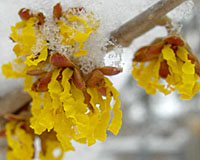 Because crosses between the Japanese and Chinese witchhazels
produce good quantities of viable seed, several dozen named H. x. intermedia hybrids have been
introduced sine the late 1940's, many by the
Kalmthout Arboretum in
Belgium. Most of these multiple-stemmed selections will be ten to
fifteen feet tall and wide at maturity and their flower color will
range from carmine red through bright yellow. The flowers of some
varieties, such as `Arnold's Promise,' also have a light fragrance
in some years.
Because crosses between the Japanese and Chinese witchhazels
produce good quantities of viable seed, several dozen named H. x. intermedia hybrids have been
introduced sine the late 1940's, many by the
Kalmthout Arboretum in
Belgium. Most of these multiple-stemmed selections will be ten to
fifteen feet tall and wide at maturity and their flower color will
range from carmine red through bright yellow. The flowers of some
varieties, such as `Arnold's Promise,' also have a light fragrance
in some years.
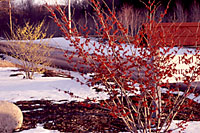 As a group, Hamamelis x. intermedia hybrids
prefer evenly moist, well-drained soils and protection from sweeping
winter winds. And, while they'll flower most heavily in full sun,
they do relatively well even in spots where they receive only four
to six hours of full sun.
As a group, Hamamelis x. intermedia hybrids
prefer evenly moist, well-drained soils and protection from sweeping
winter winds. And, while they'll flower most heavily in full sun,
they do relatively well even in spots where they receive only four
to six hours of full sun.
Other than their slightly demanding need for good site conditions, the only other limitation is that deer will browse their tender stems throughout the year in neighborhoods where other sources of food are scarce.
So, if you want to have something blooming at least some of the time between October through early April, witchhazels may be worth a look?